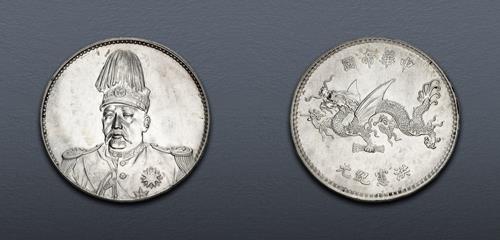
|
CHINA, Empire of China. Yuán Shìkăi. 1915-1916. AR Dollar (38mm, 26.83 g, 12h). Tiānjīn Central mint. 1919 striking of a 1916 issue. PCGS MS 63.
Triton XXVIII
Lot: 862. Estimated: $ 40 000
World, Coin-in-Hand Video, Silver
Sold For $ 67 500. This amount does not include the buyer’s fee.
Go to Live
|
|
CHINA, Empire of China. Yuán Shìkăi. 1915-1916. AR Dollar (38mm, 26.83 g, 12h). Tiānjīn Central mint. 1919 striking of a 1916 issue. Uniformed bust facing, wearing plumed kepi / Dragon flying left, holding spear and bundle of arrows. L&M 942; KM (Y) 663. In PCGS encapsulation 50741198, graded MS 63. Click here for a video presentation on this collection.
From the Alexander Christopher Collection.
After the Xinhai Revolution, a compromise was reached, leading to the abdication of Puyi – the last emperor of the Qing Dynasty. Yuan Shikai was subsequently appointed as the Provisional President of the Republic of China by the Nanking Senate. In October of the following year, Yuan was elected as the first formal President and took office in Beijing. In May of the third year of the Republic (1914), the new government issued the “Republic Commemorative Dollar,” designed by Luigi Giorgi. The coin's obverse featured Yuan Shikai wearing a plumed hat and dressed in a Military uniform. This finely crafted coin was well-received by the public.
In the fifth year of the Republic (1916), Yuan Shikai sought to restore the monarchy and proclaim himself emperor. The Minister of Finance, Zhou Xuexi, ordered the minting of a ten-yuan commemorative gold coin to raise funds and invited supporters to purchase it. The obverse design was a smaller version of Yuan Shikai's portrait from the “fat man dollar” coin, while the reverse depicted a flying dragon. The dragon had two wings on its back, and its claws held a compass and five arrows, symbolizing the emperor ruling facing south and the unity of the five races. The inscriptions “Empire of China” and “Hongxian Era” appeared on the top and bottom, with “Ten” and “Yuan” on the sides.
When the Tianjin Mint hired Giorgi, his duties included teaching staff to design drawings and engrave dies. During his time there, six students were selected by the mint to learn from him, studying dies that Giorgi had already engraved. In the eighth year of the Republic (1919), Li Boqi, who was then working at the Tianjin Mint, saw that one of the students, Tang Shangjin, had skillfully reproduced Giorgi’s flying dragon die. Impressed by his work, Li instructed him to remove the “Ten Yuan” denomination and engrave a new flying dragon die, and then combine it with the obverse die of Yuan Shikai's portrait from the 1914 Republic Commemorative Dollar. This resulted in the minting of a small batch of gold and silver coins for private gifting and orders to special VIPs, which was a common practice of the mint since the Imperial era. For more information, see: Sun Hao, Silver & Gold Coins of China, 1838-1949 (Shanghai Science and Technology Press, 2016), p. 199-201.
The type is popular among all interested in Chinese numismatics and 20th century coinage in general.
The final winners of all Triton XXVIII lots will be determined at the live public sale that will be held on 14-15 January 2025.
Triton XXVIII – Session Four – Lot 830–1154 will be held Wednesday afternoon, 15 January 2025 beginning at 2:00 PM ET.
Winning bids are subject to a 22.5% buyer's fee for bids placed on this website and 25% for all others.
We recognize that our users may have various Internet Browsers and Operating Systems. We like our visitors to have the best possible experience when using our bidding platform. However, we do recognize that it is impossible to develop applications that work identically, efficiently and effectively on all web browsers. The CNG bidding platform supports the latest stable major version and stable previous version of Chrome and Firefox.
|
